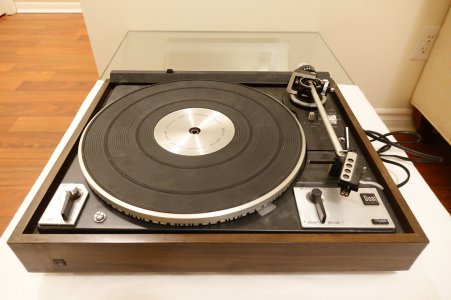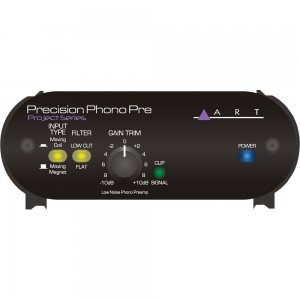- Joined
- Jan 25, 2015
- Messages
- 2,558
I've been messing around with vintage turntables for a while now. All Japanese brands from the 70s. For the most part, they all sound at least OK playing vinyl.
Yesterday, I ran across a Dual 1249 for a decent price:

Dual is German made. The 1249 is a one year model (1975), intended to commemorate Dual's 50th anniversary. It's missing a few things: dust cover (plexi cover), center pin, one of the transit lock down screws, and it supposedly is missing it's stylus although the cartridge is still there.
These are supposed to be higher end units, although just top of the middle or "mid-fi" if you want to use the audio forums slang.
It's fully automatic, meaning it will cue it's needle to the beginning and will cue it back to the stand at the end and shut off. It also has an option to repeat, just press the button and it will just keep playing the album until the power goes out.
It also has an option to "stack", meaning there's a special center post you can install, stack records on it and it will play a record, pull the tone arm back, drop the next record and repeat.
Ebay turned up a used one:

So I'll now have the stacking option.
The cartridge in it is old, but well respected. It's an ADC XLM Mk III cartridge, a TOTL moving magnet (MM) cart for it's time. I may buy a needle for it someday, but I'm going to a moving coil cartridge for better response.
Denon L-110:

That little cartridge and needle cost more than 3 times what I paid for the Dual!! Very high quality unit. Gets great reviews. Supposedly, still totally hand made in Japan.
The Denon is a High Ouput Moving Coil (HOMC) but it's still a little weak on the output voltages (approx 1.6mv) to run into a reciever/amp phono stage. You can just turn it up, but you end up with higher volume settings and if you switch to a different input...well, lets just say at a true 80watts rms per channel (and these units are known to hit far above their ratings) , my 8080DB might be able to blow the glass out of the house windows!
So phono preamp is in order:

That's a lower end one, but it gets great reviews for a budget preamp. It will step up the MC voltage to line level so I can't use the 8080db's phono inputs, but my 8080 hs multiple line in jacks, so no worries.
When the Dual gets here, first order of the day is to tear it down and give it a good cleaning and polishing. Dust, dirt, caked up grease, etc, it's all gotta go. Then it's replace worn parts, and finally adjust and get things back into spec.
That will get it up and running so I can do a good assessment on it for further repairs (if needed).
Apparently, these have a tendency for the orginial motors to go double speed on start up. So instead of 33 rpm, you get 66 pm. It seems to have something to do with Europe running on 50 hz and NA running on 60hz. Some were recalled and fixed, soe were not and some didn't experience the problem at all. There's a gent in Toronto that makes a little ciruit that eliminates the problem. If this has got the fault, I'll just order up one of those little add on circuits.
Then, it's on to modifications. Not a lot of plans there other than maybe a nice, new, heavy wooden plinth.
Now it's the waiting game for all my stuff to get here....
Yesterday, I ran across a Dual 1249 for a decent price:

Dual is German made. The 1249 is a one year model (1975), intended to commemorate Dual's 50th anniversary. It's missing a few things: dust cover (plexi cover), center pin, one of the transit lock down screws, and it supposedly is missing it's stylus although the cartridge is still there.
These are supposed to be higher end units, although just top of the middle or "mid-fi" if you want to use the audio forums slang.
It's fully automatic, meaning it will cue it's needle to the beginning and will cue it back to the stand at the end and shut off. It also has an option to repeat, just press the button and it will just keep playing the album until the power goes out.
It also has an option to "stack", meaning there's a special center post you can install, stack records on it and it will play a record, pull the tone arm back, drop the next record and repeat.
Ebay turned up a used one:

So I'll now have the stacking option.
The cartridge in it is old, but well respected. It's an ADC XLM Mk III cartridge, a TOTL moving magnet (MM) cart for it's time. I may buy a needle for it someday, but I'm going to a moving coil cartridge for better response.
Denon L-110:

That little cartridge and needle cost more than 3 times what I paid for the Dual!! Very high quality unit. Gets great reviews. Supposedly, still totally hand made in Japan.
The Denon is a High Ouput Moving Coil (HOMC) but it's still a little weak on the output voltages (approx 1.6mv) to run into a reciever/amp phono stage. You can just turn it up, but you end up with higher volume settings and if you switch to a different input...well, lets just say at a true 80watts rms per channel (and these units are known to hit far above their ratings) , my 8080DB might be able to blow the glass out of the house windows!
So phono preamp is in order:

That's a lower end one, but it gets great reviews for a budget preamp. It will step up the MC voltage to line level so I can't use the 8080db's phono inputs, but my 8080 hs multiple line in jacks, so no worries.
When the Dual gets here, first order of the day is to tear it down and give it a good cleaning and polishing. Dust, dirt, caked up grease, etc, it's all gotta go. Then it's replace worn parts, and finally adjust and get things back into spec.
That will get it up and running so I can do a good assessment on it for further repairs (if needed).
Apparently, these have a tendency for the orginial motors to go double speed on start up. So instead of 33 rpm, you get 66 pm. It seems to have something to do with Europe running on 50 hz and NA running on 60hz. Some were recalled and fixed, soe were not and some didn't experience the problem at all. There's a gent in Toronto that makes a little ciruit that eliminates the problem. If this has got the fault, I'll just order up one of those little add on circuits.
Then, it's on to modifications. Not a lot of plans there other than maybe a nice, new, heavy wooden plinth.
Now it's the waiting game for all my stuff to get here....
Last edited:

